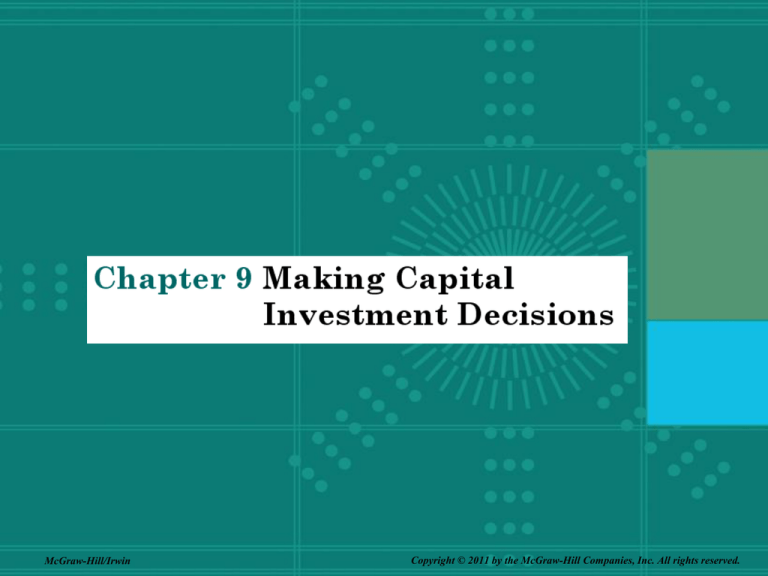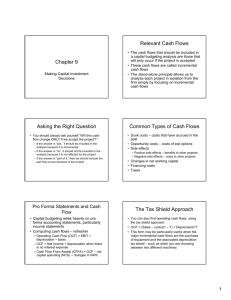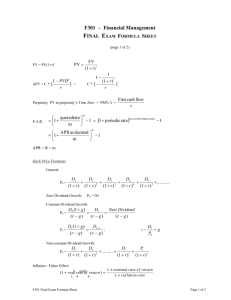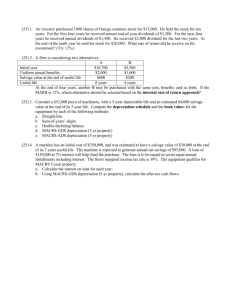
9-1
McGraw-Hill/Irwin
Copyright © 2011 by the McGraw-Hill Companies, Inc. All rights reserved.
Key Concepts and Skills
• Understand how to:
–Determine the relevant cash flows
for a proposed investment
–Analyze a project’s projected cash
flows
–Evaluate an estimated NPV
9-2
Chapter Outline
9.1
Project Cash Flows: A First Look
9.2
Incremental Cash Flows
9.3
Pro Forma Financial Statements and
Project Cash Flows
9.4
More on Project Cash Flows
9.5
Evaluating NPV Estimates
9.6
Scenario and Other What-If Analyses
9.7
Additional Considerations in Capital
Budgeting
9-3
Relevant Cash Flows
• Include only cash flows that will only
occur if the project is accepted
• Incremental cash flows
• The stand-alone principle allows us
to analyze each project in isolation
from the firm simply by focusing on
incremental cash flows
9-4
Relevant Cash Flows:
Incremental Cash Flow for a Project
Corporate cash flow with the project
Minus
Corporate cash flow without the project
9-5
Relevant Cash Flows
•
•
•
•
•
•
“Sunk” Costs ………………………… N
Opportunity Costs …………………... Y
Side Effects/Erosion……..…………… Y
Net Working Capital………………….. Y
Financing Costs….………..…………. N
Tax Effects ………………………..….. Y
9-6
Pro Forma Statements and Cash
Flow
• Pro Forma Financial Statements
– Projects future operations
• Operating Cash Flow:
OCF = EBIT + Depr – Taxes
OCF = NI + Depr if no interest expense
• Cash Flow From Assets:
CFFA = OCF – NCS –ΔNWC
NCS = Net capital spending
9-7
Shark Attractant Project
•
•
•
•
•
•
Estimated sales
Sales Price per can
Cost per can
Estimated life
Fixed costs
Initial equipment cost
50,000 cans
$4.00
$2.50
3 years
$12,000/year
$90,000
– 100% depreciated over 3 year life
• Investment in NWC
• Tax rate
• Cost of capital
$20,000
34%
20%
9-8
Pro Forma Income Statement
Table 9.1
Sales (50,000 units at $4.00/unit)
Variable Costs ($2.50/unit)
$200,00
0
125,000
Gross profit
$ 75,000
Fixed costs
12,000
Depreciation ($90,000 / 3)
30,000
EBIT
Taxes (34%)
Net Income
$ 33,000
11,220
$ 21,780
9-9
Projected Capital Requirements
Table 9.2
Year
0
NWC
1
2
3
$20,000
$20,000
$20,000
$20,000
90,000
60,000
30,000
0
Total
$110,000
Investment
$80,000
$50,000
$20,000
Net Fixed
Assets
NFA declines by the amount of depreciation each year
Investment = book or accounting value, not market value
9-10
Projected Total Cash Flows
Table 9.5
Year
0
OCF
1
$51,780
NWC
-$20,000
Capital
Spending
-$90,000
CFFA
-$110,00
2
$51,780
3
$51,780
20,000
$51,780
$51,780
$71,780
Note: Investment in NWC is recovered in final year
Equipment cost is a cash outflow in year 0
9-11
Computing NPV for the Project
Using the TI BAII+ CF Worksheet
Cash Flows:
CF0
= -110000
CF1
=
51780
CF2
=
51780
CF3
=
71780
Display
You Enter
'
C00
C01
F01
C02
F02
I
NPV
110000 S!#
51780 !#
2
!#
71780 !#
1
!#(
20
!#
%
) %
10647.69
25.76
9-12
The Tax Shield Approach to OCF
• OCF = (Sales – costs)(1 – T) + Deprec*T
OCF=(200,000-137,000) x 66% + (30,000 x .34)
OCF = 51,780
• Particularly useful when the major
incremental cash flows are the purchase of
equipment and the associated depreciation
tax shield
– i.e., choosing between two different machines
9-13
Changes in NWC
• GAAP requirements:
– Sales recorded when made, not when cash is
received
• Cash in = Sales - ΔAR
– Cost of goods sold recorded when the
corresponding sales are made, whether
suppliers paid yet or not
• Cash out = COGS - ΔAP
• Buy inventory/materials to support sales
before any cash collected
9-14
Depreciation & Capital Budgeting
• Use the schedule required by the
IRS for tax purposes
• Depreciation = non-cash expense
– Only relevant due to tax affects
• Depreciation tax shield = DT
– D = depreciation expense
– T = marginal tax rate
9-15
Computing Depreciation
• Straight-line depreciation
D = (Initial cost – salvage) / number of years
Straight Line Salvage Value
• MACRS
Depreciate 0
Recovery Period = Class Life
1/2 Year Convention
Multiply percentage in table by the initial cost
9-16
After-Tax Salvage
• If the salvage value is different from
the book value of the asset, then
there is a tax effect
• Book value = initial cost –
accumulated depreciation
• After-tax salvage = salvage –
T(salvage – book value)
9-17
Tax Effect on Salvage
Net Salvage Cash Flow
= SP - (SP-BV)(T)
Where:
SP = Selling Price
BV = Book Value
T = Corporate tax rate
9-18
Example:
Depreciation and After-tax Salvage
• Car purchased for $12,000
• 5-year property
• Marginal tax rate = 34%.
Depreciation
Year
1
2
3
4
5
6
$
$
$
$
$
$
5-year Asset
Beg BV
12,000.00
9,600.00
5,760.00
3,456.00
2,073.60
691.20
Depr %
20.00%
32.00%
19.20%
11.52%
11.52%
5.76%
100.00%
$
$
$
$
$
$
$
Deprec
2,400.00
3,840.00
2,304.00
1,382.40
1,382.40
691.20
12,000.00
$
$
$
$
$
$
End BV
9,600.00
5,760.00
3,456.00
2,073.60
691.20
-
9-19
Salvage Value & Tax Effects
Depreciation
Year
1
2
3
4
5
6
$
$
$
$
$
$
5-year Asset
Beg BV
12,000.00
9,600.00
5,760.00
3,456.00
2,073.60
691.20
Depr %
20.00%
32.00%
19.20%
11.52%
11.52%
5.76%
100.00%
$
$
$
$
$
$
$
Deprec
2,400.00
3,840.00
2,304.00
1,382.40
1,382.40
691.20
12,000.00
$
$
$
$
$
$
End BV
9,600.00
5,760.00
3,456.00
2,073.60
691.20
-
Net Salvage Cash Flow = SP - (SP-BV)(T)
If sold at EOY 5 for $3,000:
NSCF = 3,000 - (3000 - 691.20)(.34) = $2,215.01
= $3,000 – 784.99 = $2,215.01
If sold at EOY 2 for $4,000:
NSCF = 4,000 - (4000 - 5,760)(.34) = $4,598.40
= $4,000 – (-598.40) = $4,598.40
9-20
Evaluating NPV Estimates
• NPV estimates are only estimates
• Forecasting risk:
– Sensitivity of NPV to changes in cash
flow estimates
• The more sensitive, the greater the
forecasting risk
• Sources of value
• Be able to articulate why this project creates
value
9-21
Scenario Analysis
• Examines several possible situations:
– Worst case
– Base case or most likely case
– Best case
• Provides a range of possible outcomes
9-22
Scenario Analysis Example
Units
Price/unit
Variable cost/unit
Fixed Cost
Sales
Variable Cost
Fixed Cost
Depreciation
EBIT
Taxes
Net Income
+ Deprec
$
$
$
$
BASE
6,000
80.00 $
60.00 $
50,000 $
WORST
5,500
75.00 $
62.00 $
55,000 $
480,000 $
360,000
50,000
40,000
30,000
10,200
19,800
40,000
412,500 $
341,000
55,000
40,000
(23,500)
(7,990)
(15,510)
40,000
BEST
6,500
85.00
58.00
45,000
552,500
377,000
45,000
40,000
90,500
30,770
59,730
40,000
TOTAL CF
59,800
24,490
99,730
NPV
15,566
(111,719)
159,504
IRR
15.1%
-14.4%
40.9%
9-23
Problems with Scenario Analysis
• Considers only a few possible outcomes
• Assumes perfectly correlated inputs
– All “bad” values occur together and all
“good” values occur together
• Focuses on stand-alone risk,
although subjective adjustments can
be made
9-24
Sensitivity Analysis
• Shows how changes in an input variable
affect NPV or IRR
• Each variable is fixed except one
– Change one variable to see the effect on
NPV or IRR
• Answers “what if” questions
9-25
Sensitivity
Analysis:
Units
Price/unit
Variable cost/unit
Fixed cost/year
$
$
$
Base
6,000
80
60
50,000
Units
5,500
80
60
50,000
Units
6,500
80
60
50,000
Initial investment
$ 200,000
Depreciated to salvage value of 0 over 5 years
Deprec/yr
$
40,000
Unit Sales
Tax rate
Required Return
34%
12%
Units
Price/unit
Variable cost/unit
Fixed cost
BASE
6,000
80 $
60 $
50,000 $
Unit Sales Sensitivity
50,000.00
40,000.00
$39,357
$
$
$
UNITS
5,500
80 $
60 $
50,000 $
UNITS
6,500
80
60
50,000
30,000.00
NPV
20,000.00
$15,566
10,000.00
0.00
5,500
-10,000.00
6,000
$(8,226)
-20,000.00
Unit Sales
6,500
Sales
Variable Cost
Fixed Cost
Depreciation
EBIT
Taxes
Net Income
+ Deprec
$
TOTAL CF
NPV
480,000
360,000
50,000
40,000
30,000
10,200
19,800
40,000
$
59,800
$
15,566
$
440,000
330,000
50,000
40,000
20,000
6,800
13,200
40,000
$
520,000
390,000
50,000
40,000
40,000
13,600
26,400
40,000
53,200
66,400
(8,226) $
39,357
9-26
Units
Price/unit
Variable cost/unit
Fixed cost/year
Sensitivity
Analysis:
$
$
$
Base
6,000
80
60
50,000
Fixed Cost
6,000
80
60
55,000
Fixed Cost
6,000
80
60
45,000
Initial investment
$ 200,000
Depreciated to salvage value of 0 over 5 years
Deprec/yr
$
40,000
Fixed Costs
Tax rate
Required Return
34%
12%
Units
Price/unit
Variable cost/unit
Fixed cost
BASE
6,000
80 $
60 $
50,000 $
Fixed Cost Sensitivity
30,000.00
$27,461
25,000.00
$
$
$
FC
6,000
80 $
60 $
55,000 $
FC
6,000
80
60
45,000
NPV
20,000.00
$15,566
15,000.00
10,000.00
5,000.00
$3,670
0.00
$45,000
$50,000
Fixed Cost
Sales
Variable Cost
Fixed Cost
Depreciation
EBIT
Taxes
Net Income
+ Deprec
$
480,000
360,000
50,000
40,000
30,000
10,200
19,800
40,000
$
480,000
360,000
55,000
40,000
25,000
8,500
16,500
40,000
$
480,000
360,000
45,000
40,000
35,000
11,900
23,100
40,000
$55,000
TOTAL CF
NPV
59,800
$
15,566
56,500
$
3,670
63,100
$
27,461
9-27
Sensitivity Analysis:
• Strengths
– Provides indication of stand-alone risk.
– Identifies dangerous variables.
– Gives some breakeven information.
• Weaknesses
– Does not reflect diversification.
– Says nothing about the likelihood of change
in a variable,
– Ignores relationships among variables.
9-28
Disadvantages of Sensitivity and
Scenario Analysis
• Neither provides a decision rule.
– No indication whether a project’s
expected return is sufficient to
compensate for its risk.
• Ignores diversification.
– Measures only stand-alone risk, which
may not be the most relevant risk in
capital budgeting.
9-29
Managerial Options
• Contingency planning
• Option to expand
– Expansion of existing product line
– New products
– New geographic markets
• Option to abandon
– Contraction
– Temporary suspension
• Option to wait
• Strategic options
9-30
Capital Rationing
• Capital rationing occurs when a firm or
division has limited resources
– Soft rationing – the limited resources are
temporary, often self-imposed
– Hard rationing – capital will never be available
for this project
• The profitability index is a useful tool when
faced with soft rationing
9-31
Chapter 9
END





